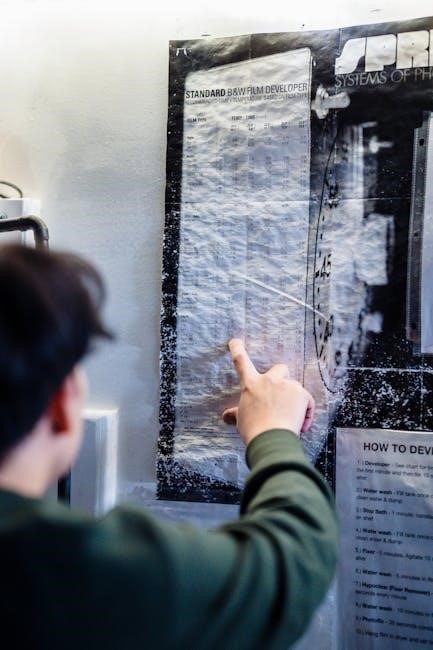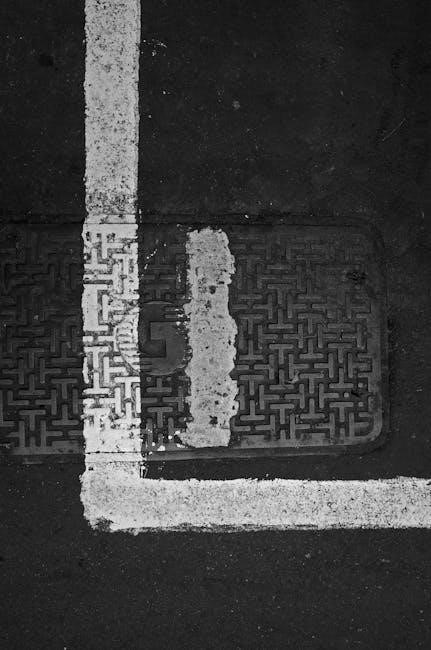The PleurX Catheter Drainage System is a minimally invasive solution for managing pleural effusions, allowing patients to drain fluid safely at home, improving lung expansion and overall comfort.
1.1 Overview of the PleurX Catheter System
The PleurX Catheter System is a minimally invasive medical device designed for draining excess fluid from the pleural space surrounding the lungs. It consists of a small, flexible catheter inserted into the chest or abdomen, connected to a vacuum bottle that assists in fluid removal. The system is user-friendly, allowing patients to drain fluid independently at home, reducing the need for repeated hospital visits. Its design promotes lung re-expansion and improves breathing comfort. The PleurX system is FDA-approved and widely used for managing conditions like pleural effusions, offering a safe and effective alternative to traditional chest tube drainage.
1.2 Importance of Proper Drainage Instructions
Proper drainage instructions are critical for the safe and effective use of the PleurX Catheter System. Adhering to guidelines ensures fluid is drained correctly, preventing complications such as infections, blockages, or lung damage. Patients must follow steps for attaching the vacuum bottle, monitoring flow, and managing re-expansion pain. Incorrect techniques can lead to incomplete drainage or discomfort. Clear instructions empower patients to maintain independence while minimizing risks. Proper care also extends the catheter’s longevity and supports overall health outcomes, making adherence to instructions essential for both safety and effectiveness.

Preparing for PleurX Catheter Placement
Preparing for PleurX Catheter placement involves medical evaluation, patient education, and site sterilization to ensure safe and effective insertion of the catheter for fluid drainage.
2.1 Medical Evaluation Before Catheter Insertion
A thorough medical evaluation is essential before PleurX Catheter insertion to assess the patient’s suitability for the procedure. This includes reviewing imaging studies, such as chest X-rays or CT scans, to confirm the presence and extent of pleural effusion. Medical history is evaluated to identify any contraindications, such as bleeding disorders or active infections. Lung function tests may also be conducted to ensure proper lung re-expansion post-drainage. Additionally, the patient’s overall health and ability to manage the catheter independently are assessed. This step ensures safe and effective catheter placement, minimizing potential risks and complications during and after the procedure.
2.2 Contraindications for Catheter Placement
Certain conditions may make PleurX Catheter placement inadvisable. Active infections, such as empyema, or the presence of loculations in the pleural fluid can complicate drainage and are contraindications. Patients with uncorrected bleeding disorders or those on anticoagulant therapy are at higher risk of hemorrhage. Additionally, individuals with prior chest surgery or diaphragmatic integrity issues may not be suitable candidates. These factors can hinder proper catheter function or increase the likelihood of complications. Evaluating these contraindications ensures safe and effective catheter placement, minimizing risks for the patient.
2.3 Preparing the Patient for the Procedure
Preparing the patient for PleurX Catheter placement involves several key steps. The patient should arrive fasting, wear loose, comfortable clothing, and remove jewelry or accessories near the insertion site. Proper hygiene practices, such as showering with antibacterial soap, are essential. The patient should be informed about the procedure, including potential discomfort and recovery expectations. Sedation or local anesthesia may be administered, so arranging transportation is necessary. Patients should also follow specific breathing instructions during insertion to ensure proper catheter placement and minimize complications. Clear communication and reassurance help reduce anxiety and ensure the patient is mentally prepared.
2.4 Sterilization and Preparation of the Insertion Site
The insertion site must be thoroughly sterilized to minimize infection risks. The area is cleaned with an antiseptic solution, and the skin is shaved if necessary. Sterile gloves and drapes are used to maintain asepsis. The patient is positioned to allow easy access to the insertion site, ensuring proper alignment for catheter placement. The site is marked with a sterile marker to guide the needle entry point. Strict adherence to sterile technique is crucial to prevent complications and ensure a successful procedure.

Insertion and Placement of the PleurX Catheter
The PleurX Catheter is inserted under imaging guidance, typically using ultrasound or fluoroscopy. A local anesthetic numbs the area, and the catheter is gently advanced into the pleural space to ensure proper placement and drainage.
3.1 Step-by-Step Guide to Catheter Insertion
The insertion process begins with preparing the patient and sterilizing the insertion site. Under imaging guidance, a local anesthetic numbs the area. A needle is used to access the pleural space, followed by the insertion of a guidewire. The catheter is then advanced over the guidewire into the pleural space. Once in place, the catheter is secured to the skin, and its position is confirmed via imaging; Proper placement ensures effective drainage and minimizes complications. The procedure is typically well-tolerated, with patients experiencing minimal discomfort due to the use of local anesthesia.
3.2 Securing the Catheter in Place
The catheter is secured using sutures or a securement device to prevent dislodgment. A sterile dressing is applied around the insertion site to protect against infection. The catheter is then looped and secured to the skin, ensuring it remains in place during movement. Proper securement minimizes the risk of catheter displacement and promotes patient comfort. The dressing should be checked regularly for integrity, and the catheter’s position should be verified to ensure it remains functional. Securement is critical for maintaining effective drainage and preventing complications.
3.3 Confirming Proper Catheter Position
Confirming proper catheter position is essential for safe and effective drainage. Imaging techniques such as chest X-rays or ultrasound are commonly used to verify the catheter’s placement within the pleural space. Clinicians also assess for signs of proper function, such as the ability to drain fluid freely and the absence of air leaks. The catheter should be positioned away from the lung parenchyma and diaphragm to avoid complications. Proper positioning ensures effective drainage, minimizes risks of injury, and promotes optimal patient outcomes. If concerns arise, additional imaging or consultation with a specialist may be necessary to confirm correct placement.

Drainage Process Using the PleurX Catheter
The PleurX catheter allows patients to drain pleural fluid using a vacuum bottle. Attach the bottle, monitor fluid flow, and ensure proper drainage to relieve symptoms and improve breathing.
4.1 Attaching the Vacuum Bottle to the Catheter
To attach the vacuum bottle, ensure the catheter is securely connected to the bottle’s drainage tube. Twist the connector until it clicks, confirming a tight seal. Gently squeeze the vacuum bottle to create suction, which will help drain fluid from the pleural space. Always check for air leaks by listening for a hiss or feeling resistance. Monitor the fluid flow into the bottle and record the amount drained. Proper attachment is crucial to maintain suction and ensure effective drainage. Follow the manufacturer’s guidelines for secure connection to avoid dislodgment or leakage during the process.
4.2 Monitoring Fluid Drainage and Flow
Monitor the fluid drainage and flow closely to ensure proper function of the PleurX Catheter. Observe the fluid as it drains into the vacuum bottle, noting its color, consistency, and volume. Clear or pale yellow fluid is normal, while bloody or cloudy fluid may indicate complications. Check for any kinks or blockages in the tubing that could impede flow. Use the graduated markings on the bottle to measure and record the amount of fluid drained. Regular monitoring helps track progress and ensures the system is working effectively. Immediate medical attention is needed if drainage stops or unusual symptoms arise.
4.3 Managing Re-Expansion Pain During Drainage
Re-expansion pain can occur as the lung expands back into the pleural space during drainage. This discomfort is typically sharp and localized to the chest. Patients should be advised to take prescribed pain relievers or use over-the-counter medications as recommended by their healthcare provider. Deep breathing exercises may also help alleviate discomfort. If pain persists or worsens, the drainage rate can be adjusted to slower intervals. It’s important to reassure patients that this pain is usually temporary and subsides as the lung fully expands. Seek medical advice if pain becomes severe or is accompanied by other concerning symptoms.

Post-Drainage Care and Maintenance
Regular cleaning of the catheter site and securing the catheter properly are essential to prevent infections and dislodgment. Monitor for signs of complications, such as redness or swelling, and ensure the vacuum bottle is stored correctly to maintain hygiene and functionality.
5.1 Cleaning and Dressing the Catheter Site
Proper cleaning and dressing of the PleurX catheter site are crucial to prevent infections and ensure long-term functionality. Use sterile saline solution or antibacterial soap to gently clean the area around the catheter. Pat dry with a clean towel. Apply a thin layer of antibiotic ointment to reduce the risk of bacterial growth. Cover the site with a sterile, occlusive dressing to protect it from contamination. Change the dressing daily or whenever it becomes damp, soiled, or loose. Always wear gloves during the process to maintain asepsis and follow the healthcare provider’s specific instructions for optimal care.
5.2 Flushing the Catheter to Prevent Blockages
Flushing the PleurX catheter is essential to maintain patency and prevent blockages. Use a sterile saline solution to flush the catheter as directed by your healthcare provider, typically after each drainage session. Gently inject the saline to ensure no resistance is met, which could indicate a blockage. If resistance occurs, avoid forcing the fluid, as this could damage the catheter. Regular flushing helps maintain proper flow and prevents complications. Always use a new, sterile syringe and solution for each flush to minimize infection risks. If blockages persist, consult your healthcare provider for further evaluation and guidance.
5.3 Storing the Vacuum Bottle and Drainage System
Proper storage of the PleurX vacuum bottle and drainage system is crucial to maintain its functionality and prevent contamination. After each use, ensure the vacuum bottle is clean and dry before storing it in a secure, dry location. Avoid exposing the system to extreme temperatures or direct sunlight. Always keep the drainage system out of the reach of children. Before reusing, inspect the bottle and tubing for any signs of damage or wear. If any damage is detected, replace the affected components immediately to ensure safe and effective drainage. Proper storage helps preserve the system’s integrity for long-term use.

Troubleshooting Common Issues
Identifying and resolving issues like blockages, leaks, or dislodgment is crucial. Regularly check for kinks, flush the catheter, and monitor for signs of infection or malfunction.
6.1 Resolving Catheter Blockages or Kinks
Catheter blockages or kinks can disrupt drainage. If fluid flow slows or stops, check for kinks and straighten the tubing. Flushing the catheter with sterile saline may resolve blockages. Use a guidewire if recommended by your healthcare provider. Avoid using force, as it may damage the catheter. If the issue persists, contact your doctor immediately to prevent complications. Regular inspection and maintenance can help prevent such problems. Always follow proper flushing techniques to ensure the catheter remains functional and patent.
6.2 Addressing Leaks or Dislodgment of the Catheter
If a leak is detected, immediately tighten all connections and inspect the catheter for damage. For dislodgment, secure the catheter at the insertion site using sterile tape or a dressing. Monitor for signs of fluid leakage or catheter movement. If the issue persists, stop drainage and contact your healthcare provider. Avoid reinserting a dislodged catheter yourself. Leaks or dislodgment can lead to infection or incomplete drainage, so prompt medical attention is crucial. Regular checks and proper securing techniques can prevent such complications. Always follow sterile procedures to maintain catheter integrity and patient safety.
6.3 Managing Infections or Redness at the Site
If redness, swelling, or pus appears at the catheter site, suspect an infection. Notify your healthcare provider immediately for evaluation and treatment. They may prescribe antibiotics or recommend cleaning the site with an antiseptic solution. Keep the area clean and dry to prevent infection spread. Avoid touching the catheter or site without proper hand hygiene. Regular dressing changes and sterile technique during drainage can minimize infection risks. If symptoms persist or worsen, seek medical attention promptly to prevent complications. Early intervention is key to resolving infections and maintaining catheter functionality.

Follow-Up and Ongoing Care
Regular medical check-ups ensure catheter functionality and monitor for complications. Proper maintenance and patient education promote independence and safety during ongoing pleural fluid drainage at home.

7.1 Scheduled Medical Check-Ups After Placement
Scheduled medical check-ups are crucial after PleurX catheter placement to monitor catheter function and overall patient health. During these visits, healthcare providers assess for complications, such as infections or blockages, and ensure proper drainage. Imaging tests may be used to confirm catheter position and lung re-expansion. Patients are also educated on signs of potential issues, such as increased pain or reduced fluid output. Regular follow-ups help maintain catheter patency and address any concerns promptly, ensuring long-term effectiveness and patient safety. These appointments are vital for optimizing outcomes and managing any emerging challenges.
7.2 Long-Term Care and Maintenance Tips
Proper long-term care of the PleurX catheter involves daily cleaning of the insertion site with antibacterial soap and water, followed by dressing with sterile gauze. Patients should monitor for signs of infection, such as redness or pus, and report them immediately. Securing the catheter with a snug dressing prevents dislodgment. Regular inspection for kinks or blockages is essential to ensure proper drainage. Flushing the catheter with saline solution, as directed, helps maintain patency. Patients should adhere to a maintenance schedule and avoid submerging the catheter in water. Proper care enhances catheter longevity and reduces the risk of complications, ensuring effective drainage and patient comfort.
7.4 When to Seek Immediate Medical Attention
Patients should seek immediate medical help if they experience severe pain, difficulty breathing, or signs of infection, such as redness, swelling, or pus around the catheter site. If the catheter becomes dislodged, kinked, or blocked, contact a healthcare provider right away. Shortness of breath or sudden chest pain may indicate improper lung expansion or fluid re-accumulation. Additionally, if drainage stops unexpectedly or if fluid appears cloudy, bloody, or foul-smelling, medical attention is required. Prompt action ensures complications are addressed early, preventing serious health issues and maintaining the effectiveness of the drainage system.

Patient Education and Safety
Proper education ensures patients use the PleurX system safely, maintain catheter hygiene, and recognize signs of complications, promoting independence and reducing risks.
8.1 Teaching Patients to Drain Fluid Safely
Teaching patients to drain fluid safely involves demonstrating proper attachment of the vacuum bottle, monitoring flow, and ensuring the system is airtight. Patients should be instructed to drain fluid slowly to minimize re-expansion pain and to stop if discomfort becomes severe. Emphasize the importance of checking for leaks and securing the catheter after drainage. Patients should also be taught to dispose of drained fluid properly and to clean the catheter site to prevent infections. Regular follow-up appointments should be encouraged to address any concerns or complications.
8.2 Ensuring Patient Comfort and Independence
Ensuring patient comfort and independence involves educating them on proper catheter management and drainage techniques. Patients should be encouraged to drain fluid in a comfortable position and take breaks if re-expansion pain occurs. The lightweight and portable design of the PleurX system allows for easy movement and independence. Patients should be taught to monitor their symptoms and adjust drainage rates as needed. Providing clear instructions and support helps patients feel confident in managing their care, improving both physical comfort and emotional well-being during the drainage process.
8.3 Discussing Risks and Benefits with Patients
Discussing the risks and benefits of PleurX catheter drainage with patients is crucial for informed decision-making. Benefits include effective fluid drainage, improved lung expansion, and reduced hospital stays. Risks may include infection, catheter blockage, or re-expansion pain. Patients should be educated on signs of complications, such as redness or swelling at the site, and the importance of proper catheter care. Open communication helps patients understand how the system improves their quality of life while addressing potential concerns. This dialogue ensures patients feel empowered and informed about their care, balancing the advantages and possible drawbacks of the procedure.
The PleurX Catheter Drainage System offers a safe, effective solution for managing pleural effusions, enhancing patient comfort and independence while improving overall quality of life significantly.
9.1 Summary of Key Drainage Instructions
Proper use of the PleurX Catheter involves attaching the vacuum bottle, monitoring fluid flow, and managing re-expansion pain. Regular flushing and site cleaning prevent blockages and infections. Patients should store the system securely and follow sterile techniques to ensure safety. Monitoring drainage volume and appearance is crucial for early detection of complications. Adhering to these steps enhances comfort, prevents infections, and maintains catheter functionality. Proper drainage techniques improve lung expansion and overall respiratory function, allowing patients to manage their condition effectively at home. Consistent adherence to guidelines ensures optimal outcomes and minimizes risks associated with pleural effusion drainage.

9.2 Encouraging Adherence to Proper Techniques
Encouraging adherence to proper drainage techniques is vital for patient safety and effective outcomes. Clear education and demonstration of the PleurX Catheter drainage process empower patients to manage their care confidently. Providing written instructions and visual aids reinforces proper methods. Regular follow-up appointments allow healthcare providers to assess technique and address concerns early. Positive reinforcement for correct practices motivates continued adherence. Emphasizing the importance of sterile technique, monitoring, and proper catheter care helps prevent complications. Consistent adherence ensures optimal drainage, reduces infection risk, and improves overall patient well-being, making home management of pleural effusions safer and more effective.
